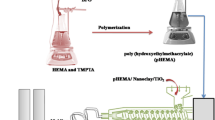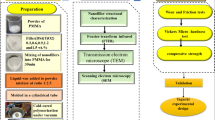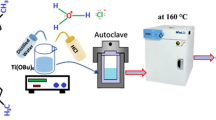Abstract
Bioactive polymeric nanocomposites are indispensable materials and have received great attention owing to their diverse applications in human body. In this study, a poly(hydroxyethyl methacrylate) (pHEMA) complex was prepared using hydroxyethyl methacrylate (HEMA) as a base material and trimethylolpropane trimethacrylate (TMPTA) and benzoyl peroxide (BPO) as cross-linking agents. The pHEMA nanocomposites were prepared by melt processing technique. In this process, a twin screw extruder machine was used. Twin screw extrusion is used extensively for mixing, compounding, or reacting polymeric materials. The flexibility of twin screw extrusion equipment allows this operation to be designed specifically for the formulation being processed. The nanocomposites of pHEMA/TiO2 and pHEMA/TiO2/GO were synthesized using pHEMA as a matrix with the addition of a small amounts of titanium oxide nanoparticles (TiO2 1 wt%) and graphene oxide (GO 0.1 wt%) as reinforcement materials. The thermomechanical study of pHEMA/TiO2 and pHEMA/TiO2/GO nanocomposites was carried out via thermogravimetric (TGA), differential scanning calorimetry (DSC), micro-indentation, micro-scratch, and FTIR analyses, and compression testing. The microstructural characterization of the nanocomposites was studied by FESEM and XRD analysis. Significant changes in microstructural behavior with improved thermomechanical properties were observed in pHEMA/TiO2 and pHEMA/TiO2/GO nanocomposites as compared to pure pHEMA. In this work, pure pHEMA and pHEMA/TiO2 and pHEMA/TiO2/GO nanocomposites were studied for dental applications.









Similar content being viewed by others
References
Nelson JK (2010) Dielectric nanocomposite polymers. Springer, New York
Koo JH (2006) Polymer nanocomposites: processing, characterization, and applications. McGraw-Hill, New York
Montheard J-P, Chatzopoulos M, Chappard D (1992) 2-Hydroxyethyl methacrylate (HEMA): chemical properties and applications in biomedical fields. J Macromol Sci Polym Rev 32:1–34
Achilias DS, Siafaka PI (2017) Polymerization kinetics of poly (2-hydroxyethyl methacrylate) hydrogels and nanocomposite materials. Processes 5:21. https://doi.org/10.3390/pr5020021
Kopperud HM, Kleven IS, Wellendorf H (2011) Identification and quantification of leachable substances from polymer-based orthodontic base-plate materials. Eur J Orthod 33:26–31
Park J-G, Ye Q, Topp EM, Kostoryz EL, Wang Y, Kieweg SL, Spencer P (2008) Preparation and properties of novel dentin adhesives with esterase resistance. J Appl Polym Sci 107:3588–3597
Yourtee DM, Smith RE, Russo KA, Burmaster S, Cannon JM, Eick JD, Kostoryz EL (2001) The stability of methacrylate biomaterials when enzyme challenged: kinetic and systematic evaluations. J Biomed Mater Res 57:522–531
Schweikl H, Spagnuolo G, Schmalz G (2006) Genetic and cellular toxicology of dental resin monomers. J Dent Res 85:870–877
Jung Y-J, Hyun H-K, Kim Y-J, Jang K-T (2009) Effect of collagenase and esterase on resin-dentin interface: a comparative study between a total-etch adhesive and a self-etch adhesive. Am J Dent 22:295–298
Rayment EA, Dargaville TR, Shooter GK, George GA, Upton Z (2008) Attenuation of protease activity in chronic wound fluid with bisphosphonate-functionalized hydrogels. Biomaterials 29:1785–1795
Schiraldi C, Agostino AD, Oliva A, Flamma F, De Rosa A, Apicella A, Aversa R, De Rosa M (2004) Development of hybrid materials based on hydroxyethylmethacrylate as supports for improving cell adhesion and proliferation. Biomater 25:3645–3653
Bolbukh Y, Klonos P, Roumpos K, Chatzidogiannaki V, Tertykh V, Pissis P (2016) Glass transition and hydration properties of polyhydroxyethylmethacrylate filled with modified silica nanoparticles. J Therm Anal Calorim 25:1387–1398
Al-Jawoosh S, Ireland A, Su B (2018) Fabrication and characterisation of a novel biomimetic anisotropic ceramic/polymer-infiltrated composite material. Dent Mater 34:994–1002
Pyrzynski K, Nyszko G, Zaikov GE (2015) Chemical and structure modification of polymers. Apple Academic Press, New York
Madhumitha G, Fowsiya J, Roopan SM, Thakur VK (2018) Recent advances in starch–clay nanocomposites. Int J Polym Anal Char 23:331–345
Salimian S, Zadhoush A, Mohammadi A (2018) A review on new mesostructured composite materials: part I. synthesis of polymer-mesoporous silica nanocomposite. J Reinf Plast Compos 37:441–459
Biswas B, Chabri S, Sawai P, Mitra BC, Das K, Sinha A (2018) Effect of aluminum addition on the mechanical and thermal behavior of unsaturated polyester/jute composites. Adv Polym Technol 37:810–821
Ojha S, Acharya SK, Raghavendra G (2015) Mechanical properties of natural carbon black reinforced polymer composites. J Appl Polym Sci 132:41211. https://doi.org/10.1002/app.41211
Hussien B, Hashim A, Jewad A (2012) Electrical properties of polyvinylchloride-Zinc composite. Eur J Soc Sci 32:225–229
Fu X, Al-Jumaily AM, Ramos M, Chen Y-F (2018) Comprehensive analysis on the electrical behavior of highly stretchable carbon nanotubes/polymer composite through numerical simulation. J Mater Res 33:3398–3407
Trommer K, Petzold C, Morgenstern B (2014) Processing and properties of carbon nanotube PVC composites. J Appl Chem. https://doi.org/10.1155/2014/307274
Selvi J, Parthasarathy V, Mahalakshmi S, Anbarasan R, Daramola MO, Kumar PS (2020) Optical, electrical, mechanical, and thermal properties and non-isothermal decomposition behavior of poly(vinyl alcohol)–ZnO nanocomposites. Iran Polym J 29:411–422
Polizos G, Tuncer E, Sauers I, James DR, Ellis AR, More KL (2010) Electrical and mechanical properties of titanium dioxide nanoparticle filled epoxy resin composites. AIP Conf Proc 1219:41–46
Bayani M, Ehsani M, Khonakdar HA, Seyfi J, HosseinAbadi-Ghaeni MH (2017) An investigation of TiO2 nanoparticles effect on morphology, thermal, and mechanical properties of epoxy/silica composites. J Vinyl Addit Technol 23:E216–E221
Casati R, Vedani M (2014) Metal matrix composites reinforced by nano-particles—a review. Metals 4:65–83
Elashmawi IS, Alatawi NS, Elsayed NH (2017) Preparation and characterization of polymer nanocomposites based on PVDF/PVC doped with graphene nanoparticles. Res Phys 7:636–640
Ge Z, Yang L, Xiao F, Wu Y, Yu T, Chen J, Lin J, Zhang Y (2018) Graphene family nanomaterials: properties and potential applications in dentistry. Int J Biomater. https://doi.org/10.1155/2018/1539678
Gómez-Navarro C, Weitz RT, Bittner AM, Scolari M, Mews A, Burghard M, Kern K (2007) Electronic transport properties of individual chemically reduced graphene oxide sheets. Nano Lett 7:3499–3503
Mosalman S, Rashahmadi S, Hasanzadeh R (2017) The effect of TiO2 nanoparticles on mechanical properties of poly methyl methacrylate nanocomposites. Int J Eng Trans B Appl 30:807–813
Alamgir M, Nayak GC, Mallick A, Tiwari SK, Mondal S, Gupta M (2018) Processing of PMMA nanocomposites containing biocompatible GO and TiO2 nanoparticles. Mater Manuf Process 33:1291–1298
Hatui G, Nayak GC, Udayabhanu G (2016) One pot solvothermal synthesis of sandwich-like Mg Al layered double hydroxide anchored reduced graphene oxide: an excellent electrode material for supercapacitor. Electrochim Acta 219:214–226
Jarrar R, Mohsin MA, Haik Y (2012) Alteration of the mechanical and thermal properties of nylon 6/nylon 6,6 blends by nanoclay. J Appl Polym Sci 124:1880–1890
Vargün E, Usanmaz A (2010) Degradation of poly(2-hydroxyethyl methacrylate) obtained by radiation in aqueous solution. J Macromol Sci A 47:882–891
Vasile E, Pandele AM, Andronescu C, Selaru A, Dinescu S, Costache M, Hanganu A, Raicopol MD, Teodorescu M (2019) Hema-functionalized graphene oxide: a versatile nanofiller for poly (propylene fumarate)-based hybrid materials. Sci Rep 9:18685. https://doi.org/10.1038/s41598-019-55081-2
Sabet M, Soleimani H, Mohammadian E, Hosseini S (2020) Impact of inclusion of graphene oxide nanosheets on polypropylene thermal characteristics. Iran Polym J 29:1099–1112
Mat Yazik MH, Sultan MTH, Shah AUM, Jawaid M, Mazlan N (2020) Effect of nanoclay content on the thermal, mechanical and shape memory properties of epoxy nanocomposites. Polym Bull 77:5913–5931
Li X, Habibnejad Korayem A, Li C, Liu Y, He H, Sanjayan JG, Duan WH (2016) Incorporation of graphene oxide and silica fume into cement paste: a study of dispersion and compressive strength. Constr Build Mater 123:327–335
Choi Y, Lee HS, Kwon D (2004) Analysis of sharp-tip-indentation load–depth curve for contact area determination taking into account pile-up and sink-in effects. J Mater Res 19:3307–3315
Acknowledgements
This research work was funded and supported by SERB, Department of Science and Technology, Govt. of India, under a research Grant (No. DST/SB/EMEQ/-020/2013).
Author information
Authors and Affiliations
Corresponding author
Rights and permissions
About this article
Cite this article
Alamgir, M., Nayak, G.C., Mallick, A. et al. Effects of TiO2 and GO nanoparticles on the thermomechanical properties of bioactive poly-HEMA nanocomposites. Iran Polym J 30, 1089–1099 (2021). https://doi.org/10.1007/s13726-021-00948-3
Received:
Accepted:
Published:
Issue Date:
DOI: https://doi.org/10.1007/s13726-021-00948-3




